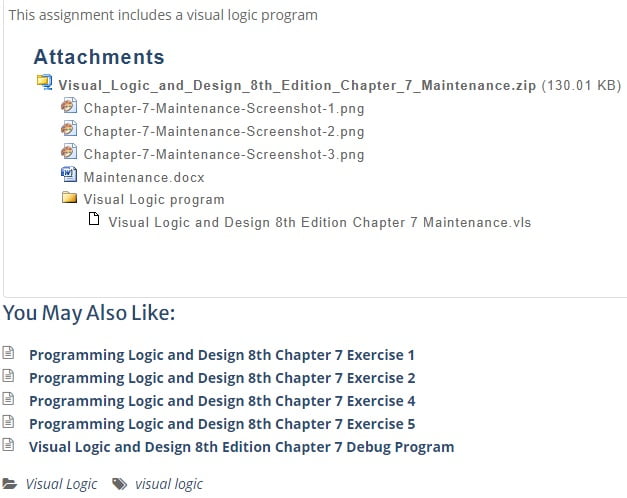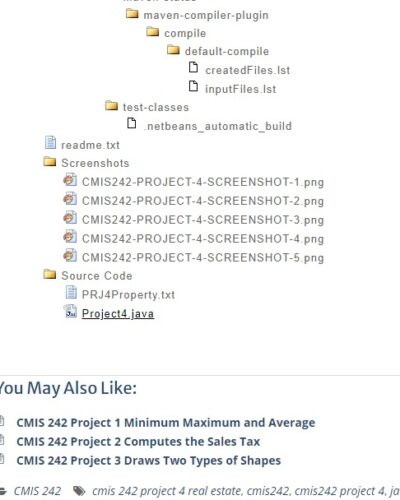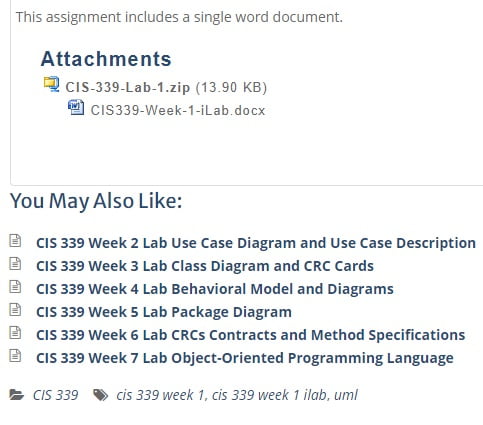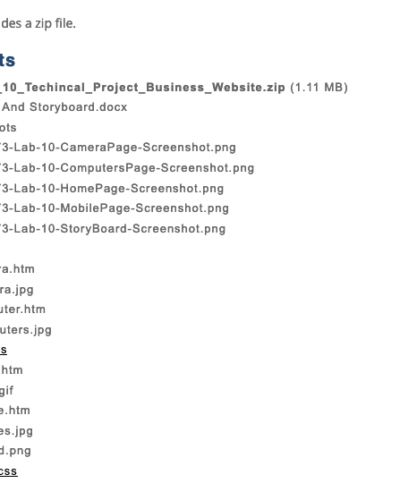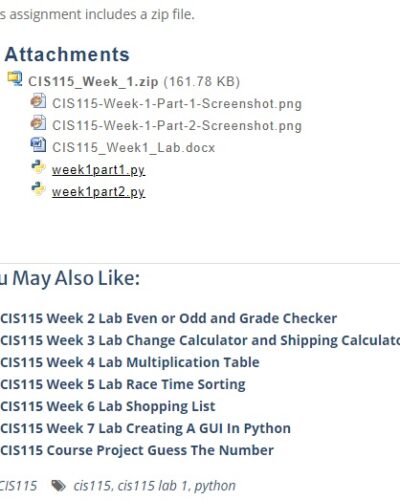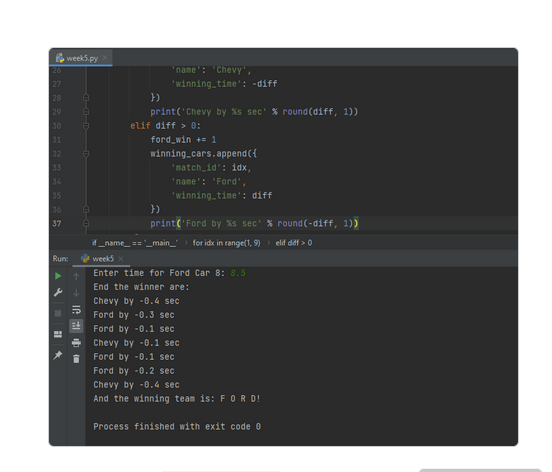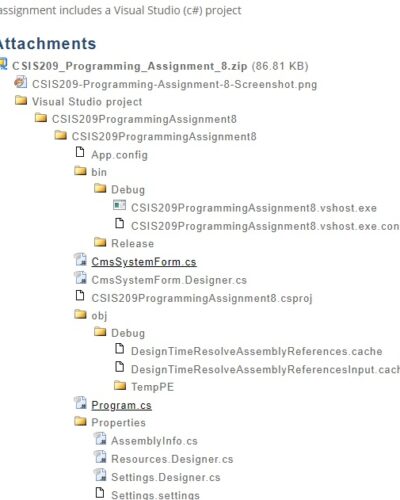VISUAL LOGIC ENTIRE COURSE HELP
$34.99$275.00
VISUAL LOGIC ENTIRE COURSE HELP
Visual Logic and Design 8th Edition Chapter 7 Maintenance
This solutions below just need to be built in Visual Logic:
Description
VISUAL LOGIC ENTIRE COURSE HELP
Visual Logic and Design 8th Edition Chapter 7 Maintenance
This solutions below just need to be built in Visual Logic:
1 2 3 4 5 6 7 8 9 10 11 12 13 14 15 16 17 18 19 20 21 22 23 24 25 26 27 28 29 30 31 32 33 34 35 36 37 38 39 40 41 42 43 44 45 46 47 48 49 50 51 52 53 54 55 56 57 58 59 60 61 62 63 64 65 66 67 68 69 70 71 72 73 74 75 76 77 78 79 80 81 82 83 84 85 86 87 88 89 90 91 92 93 94 95 96 97 98 99 100 101 102 103 104 105 106 107 108 109 110 111 112 113 114 | // Marian Basting takes in small sewing jobs.// She has two files sorted by date.// (The date is composed of two numbers -- month and year.)// One file holds new sewing projects// (such as "wedding dress")// and the other contains repair jobs// (such as "replace jacket zipper").// Each file contains the month, day, client name, phone number,// job description, and price.// Currently, this program merges the files to produce// a report that lists all of Marian's jobs for the year// in date order.// Modify the program to also display her total earnings// at the end of each month as well as at the end of the year.startDeclarationsnum newMonthnum newDaystring newNamestring newPhonestring newDescriptionnum newPricenum repairMonthnum repairDaystring repairNamestring repairPhonestring repairDescriptionnum repairPricenum newDatenum repairDatestring bothAtEof = "N"num HIGH_MONTH = 99InputFile newJobsInputFile repairJobsnum oldMonthnum total = 0num grandTotal = 0getReady()while bothAtEof = "N"detailLoop()endwhilefinish()stopgetReady()open newJobs "NewJobs.dat"open repairJobs "RepairJobs.dat"input newMonth, newDay, newName, newPhone,newDescription, newPrice from newJobsif eof thennewMonth = HIGH_MONTHendifinput repairMonth, repairDay, repairName, repairPhone,repairDescription, repairPrice from repairJobsif eof thenrepairMonth = HIGH_MONTHendifif newMonth = HIGH_MONTH AND repairMonth = HIGH_MONTH thenbothAtEof = "Y"endifif newMonth > repairMonth thenoldMonth = repairMonthelseoldMonth = newMonthendifreturndetailLoop()if newMonth <> oldMonth AND repairMonth <> oldMonth thenoutput oldMonth, totalgrandTotal = grandTotal + totaltotal = 0if newMonth > repairMonth thenoldMonth = repairMonthelseoldMonth = newMonthendifendifnewDate = newMonth * 100 + newDayrepairDate = repairMonth * 100 + repairMonth// This arithmetic turns each date into a 3- or 4-digit numberif newDate > repairDate thenoutput repairMonth, repairDay, repairName, repairPhone,repairDescription, repairPricetotal = total + repairPriceinput repairMonth, repairDay, repairName, repairPhone,repairDescription, repairPrice from repairJobsif eof thenrepairMonth = HIGH_MONTHendifelseoutput newMonth, newDay, newName, newPhone,newDescription, newPricetotal = total + newPriceinput newMonth, newDay, newName, newPhone,newDescription, newPrice from newJobsif eof thennewMonth = HIGH_MONTHendifendifif newMonth = HIGH_MONTH AND repairMonth = HIGH_MONTH thenbothAtEof = "Y"endifreturnfinish()output oldMonth, totalgrandTotal = grandTotal + totaloutput "Grand total ", grandTotalclose newJobsclose repairJobsreturn |
VISUAL LOGIC ENTIRE COURSE HELP
Visual Logic and Design 8th Edition Chapter 7 Debug Program
These solutions below just need to be built in Visual Logic.
Debug 01
1 2 3 4 5 6 7 8 9 10 11 12 13 14 15 16 17 18 19 20 21 22 23 24 25 26 27 28 29 30 31 32 33 34 35 36 37 38 39 40 41 42 43 44 45 46 47 48 49 50 51 52 53 54 55 56 57 58 59 60 61 62 63 64 65 66 67 68 69 70 71 72 73 74 75 76 77 78 | // Each time a salesperson sells a car at the// Pardeeville New and Used Auto Dealership,// a record is created containing the salesperson’s// name and the amount of the sale.// Sales of new and used cars are kept in separate files// because several reports are created for one type// of sale or the other. However, management has requested// a merged file so that all of a salesperson’s sales,// whether the vehicle was new or used,// are displayed together. The following code is intended// to merge the files that have already been// sorted by salesperson ID number.startDeclarationsstring newSalespersonnum newAmountstring usedSalespersonnum usedAmountstring bothAtEof = "N"string HIGH_NAME = "ZZZZZ"InputFile newSalesInputFile usedSalesOutputFile allsalesgetReady()while bothAtEof = "N"// bothAtEof must be "N" for loop to continuedetailLoop()endwhilefinish()stopgetReady()open newSales "NewSales.dat"open usedSales "UsedSales.dat"open allSales "AllSales.dat"input newSalesperson, newAmount from newSalesif eof thennewSalesperson = HIGH_NAME// newSalesperson should be set to HIGH_NAMEendifinput usedSalesperson, usedAmount from usedSalesif eof thenusedSalesperson = HIGH_NAME// usedSalesperson was misspelledendifif newSalesperson = HIGH_NAME AND usedSalesperson = HIGH_NAME thenbothAtEof = "Y"endifreturndetailLoop()if newSalesperson > usedSalesperson thenoutput usedSalesperson, usedAmount to allSalesinput usedSalesperson, usedAmount from usedSales// input should come from used fileif eof thenusedSalesperson = HIGH_NAMEendifelseoutput newSalesperson, newAmount to allSalesinput newSalesperson, newAmount from newSales// input should come from new fileif eof thennewSalesperson = HIGH_NAMEendifendifif newSalesperson = HIGH_NAME AND usedSalesperson = HIGH_NAME thenbothAtEof = "Y"endifreturnfinish()close newSalesclose usedSalesclose allSalesreturn |
Debug 02
1 2 3 4 5 6 7 8 9 10 11 12 13 14 15 16 17 18 19 20 21 22 23 24 25 26 27 28 29 30 31 32 33 34 35 36 37 38 39 40 41 42 43 44 45 46 47 48 49 50 51 52 53 54 55 56 57 58 59 60 61 62 63 64 65 66 67 68 69 70 71 72 73 74 75 76 77 78 79 80 | // The two senior class homerooms at Littleville High School// are having a fundraising drive for the prom. Each time a student// solicits a contribution, a record is created with the// student's name and the value. Two files have been created for// Homeroom A and Homeroom B. Each file is sorted in contribution// value order from highest to lowest. This program merges the two files.startDeclarationsstring roomANamenum roomAValuestring roomBNamenum roomBValuestring bothFilesDone = "N"num HIGH_VALUE = 999999InputFile roomAFileInputFile roomBFileOutputFile mergedFile// mergedFile is an OutputFilegetReady()while bothFilesDone = "N"detailLoop()endwhileallDone()stopgetReady()open roomAFile "roomAFile.dat"open roomBFile "roomBFile.dat"open mergedFile "mergedFile.dat"readA()readB()checkBoth()returnreadA()input roomAName, roomAValue from roomAFileif eof thenroomAValue = HIGH_VALUEendifreturnreadB()input roomBName, roomBValue from roomBFileif eof thenroomBValue = HIGH_VALUEendifreturncheckBoth()if roomAValue = HIGH_VALUE AND roomBValue = HIGH_VALUE thenbothFilesDone = "Y"endifreturndetailLoop()if roomAValue < roomBValue then// if roomBValue is more, it should be written firstoutput roomBName, roomBValue to mergedFilereadB()// should call readB()elseoutput roomAName, roomAValue to mergedFilereadA()// should call readA()endifcheckBoth()// should call checkBoth()returnallDone()close roomAFileclose roomBFileclose mergedFile// mergedFile is misspelledreturn |
Debug 03
1 2 3 4 5 6 7 8 9 10 11 12 13 14 15 16 17 18 19 20 21 22 23 24 25 26 27 28 29 30 31 32 33 34 35 36 37 38 39 40 41 42 43 44 45 46 47 48 49 50 51 52 53 54 55 56 57 58 59 60 61 62 63 64 65 66 67 68 69 70 71 72 73 74 75 76 77 78 79 80 81 82 83 84 85 86 87 88 89 90 91 92 93 94 95 | // Cooper College maintains a master file of students and credits// earned. Each semester the master is updated with a transaction// file that contains credits earned during the semester.// Each file is sorted in Student ID number order.startDeclarationsnum masterIDstring masterNamenum masterCreditsnum transIDnum transCreditsstring bothDone = "N"num HIGH_VALUE = 999999InputFile masterInputFile transOutputFile newMastergetReady()while bothDone = "N"detailLoop()endwhileallDone()stopgetReady()open master "studentFile.dat"open trans "semesterCredits.dat"open newMaster "updatedStudentFile.dat"readMaster()readTrans()checkBoth()returnreadMaster()input masterID, masterName, masterCredits from masterif eof thenmasterID = HIGH_VALUEendifreturnreadTrans()input transID, transCredits from transif eof thentransID = HIGH_VALUEendifreturncheckBoth()if masterID = HIGH_VALUE AND transID = HIGH_VALUE thenbothDone = "Y"endifreturndetailLoop()if masterID = transID thenmatch()elseif masterID > transID thennoMasterForTrans()elsenoTransForMaster()endifendifcheckBoth()// must call checkBoth()returnmatch()masterCredits = masterCredits + transCredits// should add transCredits to masterCreditsoutput masterID, masterName, masterCredits to newMasterreadMaster()readTrans()returnnoMasterForTrans()output "No master file record matches transaction ", transID// should display transIDreadTrans()returnnoTransForMaster()output masterID, masterName, masterCredits to newMasterreadMaster()// should call readMaster()returnallDone()close masterclose transclose newMasterreturn |
Debug 04 must be corrected and put into Visual Logic and pseudo code.


VISUAL LOGIC ENTIRE COURSE HELP
Programming Logic and Design 8th Chapter 7 Exercise 5
The Martin Weight Loss Clinic maintains two patient files—one for male clients and one for female clients. Each record contains the name of a patient and current total weight loss in pounds. Each file is in descending weight loss order. Design the logic that merges the two files to produce one combined file in order by weight loss.
VISUAL LOGIC ENTIRE COURSE HELP
Programming Logic and Design 8th Chapter 7 Exercise 4
The Apgar Medical group keeps a patient file for each doctor in the office. Each record contains the patient’s first and last name, home address, and birth year. The records are sorted in ascending birth year order. Two doctors, Dr. Best and Dr. Cushing, have formed a partnership.
Design the logic that produces a merged list of patients’ names in ascending order by birth year.
VISUAL LOGIC ENTIRE COURSE HELP
Programming Logic and Design 8th Chapter 7 Exercise 2
Boardman College maintains two files—one for Sociology majors and another for Anthropology majors. Each file contains students’ ID numbers, last names, first names, and grade point averages. Each file is in student ID number order. The college is merging the two departments into a Department of Sociology and Anthropology. Design the logic for a program that merges the two files into one file containing a list of all students, maintaining ID number order.
VISUAL LOGIC ENTIRE COURSE HELP
Programming Logic and Design 8th Chapter 7 Exercise 1
The Vernon Hills Mail-Order Company often sends multiple packages per order. For each customer order, output enough mailing labels to use on each of the boxes that will be mailed. The mailing labels contain the customer’s complete name and address, along with a box number in the form Box 9 of 9. For example, an order that requires three boxes produces three labels: Box 1 of 3, Box 2 of 3, and Box 3 of 3. Design an application that reads records that contain a customer’s title (for example, Mrs.), first name, last name, street address, city, state, zip code, and number of boxes. The application must read the records until eof is encountered and produce enough mailing labels for each order.
VISUAL LOGIC ENTIRE COURSE HELP
Visual Logic and Design Random Flags Program
Write a visual logic program that uses a flag procedure to draw 10 flags at random locations. Every time you run the program, the flags should show up at different locations on the screen. Therefore, the position of your 10 flags will be different than those shown in the figure below.
VISUAL LOGIC ENTIRE COURSE HELP
Visual Logic and Design 8th Edition Chapter 6 Maintenance
This solutions below just need to be built in Visual Logic:
1 2 3 4 5 6 7 8 9 10 11 12 13 14 15 16 17 18 19 20 21 22 23 24 25 26 27 28 29 30 31 32 33 34 35 36 37 38 39 40 41 42 43 44 45 46 47 48 49 50 51 52 53 54 55 56 57 | // Sunrise Freight charges standard // per-pound shipping prices to the five states they serve // –- IL IN OH MI WI // -- 0.60 0.55 0.70 0.65 0.67 // Modify this program to reduce its size // by using arrays start Declarations string state num pounds num SIZE = 5 string STATES[SIZE] = [“IL”, “IN”, “OH”, “MI”, “WI”] num PRICES[SIZE] = [0.60, 0.55, 0.70, 0.65, 0.67] num sub string foundIt string BAD_STATE_MSG = "Sorry, we do not ship to ” string FINISH = “XXX” getReady() while state <> FINISH findPrice() endwhile finishUp() stop getReady() output "Enter state or ", FINISH, " to quit" input state returnfindPrice() foundIt = "N" sub = 0 index = 0 while sub < SIZE if state = STATES[sub] then foundIt = "Y" index = sub sub = SIZE endif sub = sub + 1 endwhile if foundIt = "N" then output BAD_STATE_MSG, state else price = PRICES[index] output “Enter pounds “ input pounds output “Cost per pound to ship to ”, state, “ is ”, price output “Total cost is ”, price * pounds endif output "Enter next state or ", FINISH, " to quit" input state returnfinishUp() output "End of job"return. |
VISUAL LOGIC ENTIRE COURSE HELP
Visual Logic and Design 8th Edition Chapter 6 Debug Program
These solutions below just need to be built in Visual Logic.
Debug 01
1 2 3 4 5 6 7 8 9 10 11 12 13 14 15 16 17 18 19 20 21 22 23 24 25 26 27 28 29 30 31 32 | // A high school is holding a recycling competition// This program allows a user to enter a student's// year in school (1 through 4) and number of cans collected// Data is entered continuously until the user enters 9// After headings, output is four lines --// one for each school year classstart Declarations num year num cans num SIZE = 4 num QUIT = 9num collectedArray[SIZE] = 0, 0, 0, 0 string HEAD1 = "Can Recycling Report" string HEAD2 = "Year Cans Collected" output "Enter year of student or ", QUIT, " to quit " input year while year <> QUIT output "Enter number of cans collected " input cans collectedArray[year - 1] = collectedArray[year - 1] + cans output "Enter year of student or ", QUIT, " to quit " input year endwhile output HEAD1 output HEAD2 year = 1 while year <= SIZE output year, collectedArray[year - 1] year = year + 1 endwhilestop |
Debug 02
1 2 3 4 5 6 7 8 9 10 11 12 13 14 15 16 17 18 19 20 21 22 23 24 25 26 27 28 29 30 31 32 33 34 35 36 | // Program lets user input scores on four tests// Average is computed and letter grade is determined// Letter grades are based on 90 for an A, 80 for a B, and so onstart string name num score num NUM_TESTS = 4 num NUM_RANGES = 5 num RANGES[NUM_RANGES] = 90, 80, 70, 60, 0 string QUIT = "ZZZZZ" string GRADES[NUM_RANGES] = "A", "B", "C", "D", "F" num total num average num sub output "Enter student name or ", QUIT, " to quit " input name while name <> QUIT sub = 0 total = 0 while sub < NUM_TESTS output "Enter score " input score total = total + score sub = sub + 1 endwhile average = total / NUM_TESTS sub = 0while average < RANGES[sub] sub = sub + 1 endwhile letterGrade = GRADES[sub] output name, letterGrade output "Enter student name or ", QUIT, " to quit " input name endwhilestop |
Debug 03
1 2 3 4 5 6 7 8 9 10 11 12 13 14 15 16 17 18 19 20 21 22 23 24 25 26 27 28 29 30 31 | // This program counts how many sales are made// in each of five categories of productsstart Declarations num category num SIZE = 5 num QUIT = 9 num sales[SIZE] = 0, 0, 0, 0, 0 string HEAD1 = "Sales" string HEAD2 = "Category Number of Sales" output "Enter category ", QUIT, " to quit " input category while category <> QUIT if category >= 1 AND category <= SIZE then sales[category - 1] = sales[category - 1] + 1 else output "Invalid category" endif output "Enter category ", QUIT, " to quit " input category endwhile output HEAD1 output HEAD2 category = 0 while category < SIZE output category + 1, sales[category] category = category + 1 endwhilestop |
Debug 04 must be corrected and put into Visual Logic and pseudo code.


VISUAL LOGIC ENTIRE COURSE HELP
Programming Logic and Design 8th Chapter 6 Exercise 10
Countrywide Tours conducts sightseeing trips for groups from its home base in Iowa. Create an application that continuously accepts tour data, including a three-digit tour number, the numeric month, day, and year values representing the tour start date, the number of travelers taking the tour, and a numeric code that represents the destination. As each tour’s data is entered, verify that the month, day, year, and destination code are valid; if any of these is not valid, continue to prompt the user until it is. The valid destination codes are shown in Table 6-6.
| Code, | Destination, | Price per Person ($) |
|---|---|---|
| 1, | Chicago,300.00 | |
| 2, | Boston, | 480.00 |
| 3, | Miami,1050.00 | |
| 4, | San Francisco, | 1300.00 |
Table 6-6 Countrywide Tours codes and prices
Design the logic for an application that outputs each tour number, validated start date, destination code, destination name, number of travelers, gross total price for the tour, and price for the tour after discount. The gross total price is the tour price per guest times the number of travelers. The final price includes a discount for each person in larger tour groups, based on Table 6-7.
| Number of Tourists, | Discount per Tourist ($) |
|---|---|
| 1-5, | 0 |
| 6-12, | 75 |
| 13-20, | 125 |
| 21-50, | 200 |
| 51 and over, | 300 |
Table 6-7 Countrywide Tours discounts
This tutorial built in Visual Logic, along with pseudo code.
VISUAL LOGIC ENTIRE COURSE HELP
Programming Logic and Design 8th Chapter 6 Exercise 9
Design a program that computes pay for employees. Allow a user to continuously input employees’ names until an appropriate sentinel value is entered. Also input each employee’s hourly wage and hours worked. Compute each employee’s gross pay (hours times rate), withholding tax percentage (based on Table 6-5), withholding tax amount, and net pay (gross pay minus withholding tax). Display all the results for each employee. After the last employee has been entered, display the sum of all the hours worked, the total gross payroll, the total withholding for all employees, and the total net payroll.
| Weekly Gross Pay ($), | Withholding Percent (%) |
|---|---|
| 0.00 – 300.00, | 10 |
| 300.01 – 550.00, | 13 |
| 550.01 – 800.00, | 16 |
| 800.01 – up.000 , | 20 |
Table 6-5 Withholding percentage based on gross pay
This tutorial built in Visual Logic, along with pseudo code.
VISUAL LOGIC ENTIRE COURSE HELP
Programming Logic and Design 8th Chapter 6 Exercise 8
Design the application logic for a company that wants a report containing a breakdown of payroll by department. Input includes each employee’s department number, hourly salary, and number of hours worked. The output is a list of the seven departments in the company and the total gross payroll (rate times hours) for each department. The department names are shown in Table 6-4.
| Department Number | Department Name |
|---|---|
| 1 | Personnel |
| 2 | Marketing |
| 3 | Manufacturing |
| 4 | Computer Services |
| 5 | Sales |
| 6 | Accounting |
| 7 | Shipping |
This tutorial built in Visual Logic, along with pseudo code.
VISUAL LOGIC ENTIRE COURSE HELP
Programming Logic and Design 8th Chapter 6 Exercise 7
The Jumpin’ Jive coffee shop charges $2.00 for a cup of coffee, and offers the add-ins shown in Table 6-3.
| Product | Price ($) |
|---|---|
| Whipped cream | 0.89 |
| Cinnamon | 0.25 |
| Chocolate sauce | 0.59 |
| Amaretto | 1.50 |
| Irish whiskey | 1.75 |
Design the logic for an application that allows a user to enter ordered add-ins continuously until a sentinel value is entered. After each item, display its price or the message Sorry, we do not carry that as output. After all items have been entered, display the total price for the order.
This tutorial built in Visual Logic, along with pseudo code.
VISUAL LOGIC ENTIRE COURSE HELP
Visual Logic and Design 8th Edition Chapter 5 Maintenance
Please help perform maintenance to this pseudo code so it is written to match the comments behind the //
[chapter 5-01 maintenance] Programming Logic and design Introductory Joyce Farrell
1 2 3 4 5 6 7 8 9 10 11 12 13 14 15 16 17 18 19 20 21 22 23 24 25 26 27 28 29 30 31 32 33 34 35 36 37 38 39 40 41 42 43 44 45 46 47 48 49 50 51 52 53 54 55 56 57 58 59 60 61 62 63 64 65 66 67 68 69 70 | // The QuickCopy company currently makes 60,000 copies per year// at 15 cents each.// They expect to increase the number of copies produced// by 4 percent per year each year for the next 10 years,// starting with this year.// They also expect the price of each copy to increase// by 3 cents per year, starting with this year.// This program displays the company's expected// income for each of the next 10 years.// Modify it to be more efficient.startDeclarationsnum year = 1num copies = 60000num price = 0.15num total = 0num COPIES_INCREASE = 0.04num PRICE_INCREASE = 0.03copies = copies + copies * COPIES_INCREASEprice = price + price * PRICE_INCREASEtotal = total + copies * priceoutput year, totalyear = year + 1copies = copies + copies * COPIES_INCREASEprice = price + price * PRICE_INCREASEtotal = total + copies * priceoutput year, totalyear = year + 1copies = copies + copies * COPIES_INCREASEprice = price + price * PRICE_INCREASEtotal = total + copies * priceoutput year, totalyear = year + 1copies = copies + copies * COPIES_INCREASEprice = price + price * PRICE_INCREASEtotal = total + copies * priceoutput year, totalyear = year + 1copies = copies + copies * COPIES_INCREASEprice = price + price * PRICE_INCREASEtotal = total + copies * priceoutput year, totalyear = year + 1copies = copies + copies * COPIES_INCREASEprice = price + price * PRICE_INCREASEtotal = total + copies * priceoutput year, totalyear = year + 1copies = copies + copies * COPIES_INCREASEprice = price + price * PRICE_INCREASEtotal = total + copies * priceoutput year, totalyear = year + 1copies = copies + copies * COPIES_INCREASEprice = price + price * PRICE_INCREASEtotal = total + copies * priceoutput year, totalyear = year + 1copies = copies + copies * COPIES_INCREASEprice = price + price * PRICE_INCREASEtotal = total + copies * priceoutput year, totalyear = year + 1copies = copies + copies * COPIES_INCREASEprice = price + price * PRICE_INCREASEtotal = total + copies * priceoutput year, totalstop |
1 2 3 4 5 6 7 8 9 10 11 12 13 14 15 16 17 | startDeclarationsnum year = 1num copies = 60000num price = 0.15num total = 0num COPIES_INCREASE = 0.04num PRICE_INCREASE = 0.03num YEARS = 10while year <= YEARScopies = copies + copies * COPIES_INCREASEprice = price + price * PRICE_INCREASEtotal = total + copies * priceoutput year, totalyear = year + 1endwhilestop |
The solution built in Visual Logic
VISUAL LOGIC ENTIRE COURSE HELP
Visual Logic and Design 8th Edition Chapter 5 Debug Program
Following the comments, each file contains a psuedocode that has one or more bugs you must find and correct.
These solutions need to be built in Visual Logic.
Debug 05-01:
1 2 3 4 5 6 7 8 9 10 11 12 13 14 | // This program is supposed to display every fifth year// starting with 2010; that is, 2010, 2015, 2020,// and so on, for 30 years.start Declarations num year num START_YEAR = 2010 num FACTOR = 5 num END_YEAR = 2040 while year <= END_YEAR output year endwhile year = year + FACTORstop |
Debug 05-02:
1 2 3 4 5 6 7 8 9 10 11 12 13 14 15 16 17 18 19 20 21 22 23 24 25 26 27 28 29 30 31 32 33 34 35 36 37 38 | // A standard mortgage is paid monthly over 30 years.// This program is intended to print 360 payment coupons// for each new borrower at a mortgage comapny. Each coupon// lists the month number, year number, and a friendly mailing reminder.start Declarations num MONTHS = 12 num YEARS = 360 string MSG = "Remember to allow 5 days for mailing" num acctNum num monthCounter num yearCounter housekeeping() while acctNUm <> QUIT printCoupons() endwhile finish()stophousekeeping() print "Enter account number or ", QUIT, " to quit "returnprintCoupons() while yearCounter <= YEARS while monthCounter <= MONTHS print acctNum, monthCounter, yearCounter, MSG monthCounter = monthCounter + 1 endwhile yearCounter = yearCounter + 1 endwhile output "Enter account number or ", QUIT, " to quit " input acctNumreturnfinish() output "End of job"return |
Debug 05-03:
1 2 3 4 5 6 7 8 9 10 11 12 13 14 15 16 17 | // This program displays every combination of three-digit numbersstart Declarations num digit1 num digit2 num digit3 while digit1 <= 9 while digit1 <= 9 while digit3 <= 9 output digit1, digit2, digit3 endwhile endwhile digit1 = digit1 + 1 digit3 = digit2 + 1 digit2 = digit3 + 1 endwhilestop |
Debug 05-04:
Your downloadable files for Chapter 5 include a file named DEBUG05-04.jpg that contains a flowchart with syntax and/or logical errors. Examine the flowchart and then find and correct all the bugs.


VISUAL LOGIC ENTIRE COURSE HELP
Programming Logic and Design 8th Chapter 5 Exercise 13
Design a retirement planning calculator for Skulling Financial Services. Allow a user to enter a number of working years remaining in the user’s career and the annual amount of money the user can save. Assume that the user earns three percent simple interest on savings annually. Output is a schedule that lists each year number in retirement starting with year 0 and the user’s savings at the start of that year. Assume that the user spends $50,000 per year in retirement and then earns three percent interest on the remaining balance. End the list after 40 years or when the user’s balance is 0 or less, whichever comes first.
VISUAL LOGIC ENTIRE COURSE HELP
Programming Logic and Design 8th Chapter 5 Exercise 8
Design the logic for a program that allows a user to enter any quantity of numbers until a negative number is entered. Then display the highest number and the lowest number.
The solution built in Visual Logic, along with pseudo code.
VISUAL LOGIC ENTIRE COURSE HELP
Programming Logic and Design 8th Chapter 5 Exercise 5
Design the logic for a program that outputs numbers in reverse order from 25 down to 0.
The solution built in Visual Logic, along with pseudo code.
VISUAL LOGIC ENTIRE COURSE HELP
Programming Logic and Design 8th Chapter 5 Exercise 3
Design the logic for a program that outputs every number from 1 through 20 along with its value doubled and tripled.
The solution built in Visual Logic, along with pseudo code.
VISUAL LOGIC ENTIRE COURSE HELP
Visual Logic and Design 8th Edition Guessing Number Program
Draw a structured flowchart or write pseudocode that describes the process of guessing a number between 1 and 100. After each guess, the player is told that the guess is too high or too low. The process continues until the player guesses the correct number. Pick a number and have a fellow student try to guess it following your instructions.
The solution built in visual logic
VISUAL LOGIC ENTIRE COURSE HELP
Visual Logic Body Mass Index program
Draw the hierarchy chart and then plan the logic for a program that calculates a person’s body mass index (BMI).
BMI is a statistical measure that compares a person’s weight and height. The program uses three modules:
- The first prompts a user for and accepts the user’s height in inches.
- The second module accepts the user’s weight in pounds and converts the user’s height to meters and weight to kilograms.
- Then, it calculates BMI as weight in kilograms divided by height in meters squared, and displays the results.
There are 2.54 centimeters in an inch, 100 centimeters in a meter, 453.59 grams in a pound, and 1,000 grams in a kilogram. Use named constants whenever you think they are appropriate.
The last module displays the message End of job.
Revise the BMI-determining program to execute continuously until the user enters 0 for the height in inches.
Submit the .vls file you create in Visual Logic as well as a screenshot of the output.
For full credit, the program must function correctly, produce the correct answer, and be logically succinct.
VISUAL LOGIC ENTIRE COURSE HELP
Visual Logic Program The Henry Used Car Dealership
Draw the hierarchy chart and then plan the logic for a program needed by the sales manager of The Henry Used Car Dealership. The program will determine the profit on any car sold. Input includes the sale price and actual purchase price for a car. The output is the profit, which is the sale price minus the purchase price. Use three modules. The main program declares global variables and calls housekeeping, detail, and end-of-job modules. The housekeeping module prompts for and accepts a sale price. The detail module prompts for and accepts the purchase price, computes the profit, and displays the result. The end-of-job module displays the message Thanks for using this program.
Complete the labs using Visual Logic in which you:
- Submit the .vls file you create in Visual Logic as well as a screenshot of the output. For full credit, the program must function correctly, produce the correct answer, and be logically succinct.
- Write a short answer (four to five [4-5] sentences) in the comment text box located with the assignment submission link to the following:
- A summary of the technical experiences that you used in completing this lab.
- The commands that were of greatest benefit to you.
- Your general comments on the overall lab experience.
VISUAL LOGIC ENTIRE COURSE HELP
Visual Logic Vacation Program
Create the logic for a program that accepts input values for the projected cost of a vacation and the number of months until vacation. Pass both values to a method that displays the amount you must save per month to achieve your goal.
VISUAL LOGIC ENTIRE COURSE HELP
Assignment 2 Frans Virtual Fruit Stand Part 2
Use the concepts and scenario from Assignment 1 to help Fran’s Virtual Fruit Stand increase the functionality of its online shopping cart. When a customer checks out, the shopping cart must store the required data pertaining to each item the customer is buying. Your job is to design a program that will prompt the user for the required data and then store it. The required data includes the item name, the price per pound, and the number of pounds of that item being purchased. When complete, your program should include three (3) arrays, two (2) loops, one (1) and / or conditional statement, and one (1) variable.
Using Visual Logic, design a flowchart that is also a fully functional program to add functionality to the online shopping cart. According to your design, the program must:
- Continually accept data regarding the purchase of fruit as specified below until the user enters a sentinel value, or until five (5) items are entered, whichever comes first.
- Prompt the user for each item and accept the name of the fruit (e.g., “dried apples”), the price per pound, and the number of pounds sold in a month.
- Store the required data in three (3) arrays (e.g., one (1) for the item name, one (1) for the price per pound, and one (1) for the number of pounds being purchased) with corresponding index values. Note: For example, index value 3, when applied to the “itemName” array, would give us the name of the third item that the customer is buying. That same index value of 3, when applied to the “pricePerPound” array, would give us the price per pound of that same third item that the customer is buying.
- Store up to five (5) values in each of the three (3) arrays.
- Provide functionality in which the user ends the program by typing a sentinel value, and the program tells the user what the sentinel value is. Note: An acceptable message may read “Type n to end the program.”, where “n” is the sentinel value. If the user does not end the program in this way, then the program ends when it has collected the data for five (5) items.
- Print an itemized receipt with the following data after the last item in the purchase has been saved to the array.
Item name
Price per pound of each item
Number of pounds purchased of each item
Subtotal price for each item, calculated as price per pound multiplied by the number of pounds
Total weight of the entire order (in pounds)
The cost of shipping which is based on the total weight of the entire order, calculated as 50 cents per pound. Note: For example, if the entire order weighs seven (7) pounds, the cost of shipping would be $3.50.
Grand total price of all items and shipping.
VISUAL LOGIC ENTIRE COURSE HELP
Assignment 1 Frans Virtual Fruit Stand Part 1
Fran’s Virtual Fruit Stand is an online store that sells several types of dried fruit. Based on the needs of Fran’s Virtual Fruit stand, you must design a flowchart using Visual Logic. The flowchart must also be a fully functional program which follows the design requirements below.
Note: This program does not require the use of arrays. The program will prompt for data on a single item, process that data, display any relevant messages as described below, and then move on to the next item. Use the “console” option in the output command to display the output in a single window. Displaying the output can be accomplished with as few as three (3) variables that simply get overwritten each time the loop repeats.
Using Visual Logic, design a flowchart that is also a fully functional program. According to your design, the program must:
- Continually accept data regarding the purchase of fruit until a sentinel value is entered.
- Prompt the user for each item, and accept the name of the fruit (e.g., “dried apples”), the price per pound, and the number of pounds sold in a month.
Display a clear message for items that are considered:
- Best-selling items
Note: Best-selling items are identified as those that sell 5,000 or more pounds per month on average. For example, an acceptable message may read, “Yellow raisins are a best-selling item.” - Big-ticket items
Note: Big-ticket items are identified as those that are best-selling items and also cost $4 per pound or more. For example, an acceptable message may read, “Freeze-dried blueberries are a big-ticket item.” - High-priced items
Note:High-priced items are identified as those that sell for $7 per pound or more. For example, an acceptable message may read, “Dried mangos are a high-priced item.” - Lowest-selling items
Note: Lowest-selling items are identified as those that sell 500 pounds or less per month on average. For example, an acceptable message may read, “Dried Ugli Fruit is a lowest-selling item.” - High-income generating items
Note: High-income generating items are identified as those that generate $7,000 or more per month on average. To determine the income generated per item, multiply the price per pound by the number of pounds sold per month. If the item generates $7,000 or more per month, an acceptable message may read, “Dried pineapple chunks are a high-income generating item.”
Loop through all of the above steps until the user types the sentinel value when prompted. Display the sentinel value so that the user may ultimately be able to demonstrate an understanding of the way in which to end the program. Note: An acceptable message may read “Type n to end the program.”, where “n” is the sentinel value.
Your Visual Logic program must follow these formatting requirements:
- Be accomplished in a single Visual Logic program.
- Be submitted as a single file with the “.vls” file extension.
- Be fully functional in order to receive full credit.
The specific course learning outcomes associated with this assignment are:
- Demonstrate the use of algorithms and pseudocoding to the problem-solving process.
- Distinguish among the basic types, steps, and properties of programming.
- Apply the techniques of functional decomposition, modularization techniques, and debugging strategies into program design.
- Describe the features and fundamental data structures of programming design.
- Select and create the appropriate conditional and iteration constructs for a given programming task.
VISUAL LOGIC ENTIRE COURSE HELP
Visual Logic Average Program
Design the logic for a program that allows a user to enter 15 numbers, then displays each number and its difference from the numeric average of the numbers entered.
Modify the program in 2a so that the user can enter any amount of numbers up to 15 until sentinel value is entered.
VISUAL LOGIC ENTIRE COURSE HELP
Programming Logic and Design Eight Edition Chapter 10 Exercise 4
Design a class named Automobile that holds the vehicle identification number, make, model, and color of an automobile. Include methods to set the values for each data field, and include a method that displays all the values for each field. Create the class diagram and write the pseudocode that defines the class.
VISUAL LOGIC ENTIRE COURSE HELP
Programming Logic and Design Eight Edition Chapter 4 Exercise 5 A
ShoppingBay is an online auction service that requires several reports. Data for each item up for auction includes ID number, item description, length of auction in days, and minimum required bid. Design for the following:
- A program that accepts data for one auctioned item.
- Display data for an auction only if the minimum required bid is over $100.00
VISUAL LOGIC ENTIRE COURSE HELP
Programming Logic and Design Eight Edition Chapter 9 Exercise 4
Create the logic for a program that accepts an annual salary as input. Pass the salary to a method that calculates the highest monthly housing payment the user can afford, assuming that the year’s total payment is no more than 25 percent of the annual salary.

